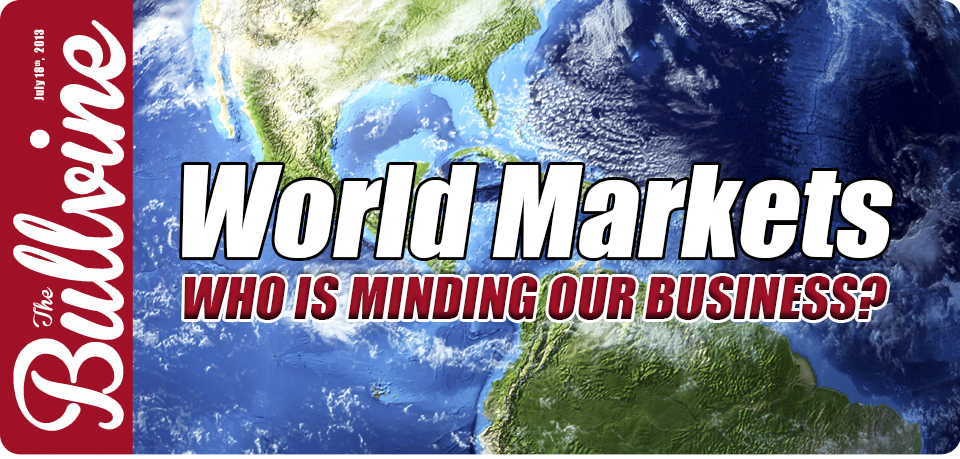In North America we are accustomed to having the freedom to pursue our chosen business, in our case dairying and to proudly wave our American and Canadian flags at every opportunity. We assume that all is well with the world when we can raise cattle, make milk and pay the bills on a regular basis. In June 2013 I read a Hoard’s Dairyman article by Utah dairy producer, John Nye entitled, “Opportunity Knocks, New Zealand’s Fonterra Answers”. It turned out to be a wakeup call for me.
I don’t have a background in finance and economics but I will admit I am reassured by headlines that say things like “Markets well supported at mid-year” or “U.S. exports reach record levels in April”
The shrinking world is a fact of everyday life. It’s exciting to correspond with fellow dairy breeders from every corner of the globe and share our dairy passions. We can – and do – learn from one another. Dairy genetics, dairy technology and dairy sales are being shared worldwide. What we may be missing is the very important point of who controls what we are taking to the bank today and, most definitely, what our financial success will be tomorrow. When our hard earned dairy dollar takes a dive we blame it on the weather, the government, the fickle market or numerous variables that are out of our control. Realistically, we should be blaming at least some of the effect on ourselves!
We take huge care to see that genetics inputs and management don’t skim off our profits but then we leave the economics of the marketplace in other hands.
Three facts from the previously mentioned Fonterra article stood out for me. Firstly, Fonterra owns enough supply in the US that they could dump supply domestically thus lowering prices and therefore making the export of US product more affordable for them. Secondly, Fonterra’s partnership in mega dairies (10,000 to 20,000 cow dairies in China) gives them the financial leverage to pay twice what Americans can afford for alfalfa hay. And thirdly this raised the question for John Nye, “How does New Zealand that produces about as much milk as Wisconsin, control the world`s market like they do?”
As a Canadian, with supply management in place, it’s hard to imagine that our hard earned dairy income could be manipulated by outside forces from another county. Or is it? If we are so focused on keeping a protected wall around our shrinking dairy market, would we even notice if a third party came in and quietly scooped up the opportunities for growth and development?
What is the growing edge of the dairy industry in 2013? If you can’t answer that question, that is exactly what has allowed companies like Fonterra and investors from offshore to make billions of dollars at the expense of a naive North American dairy industry. As Nye quotes in the article, “Fonterra’s attitude is that dairymen in the U.S. could not agree on what kind of rope to hang themselves with. As long as we are divided on dairy policy, Fonterra is very happy to take advantage of us.” The finger of blame for who is responsible for this predicament points squarely at us, “They are pretty sure we will never get together as an industry with one voice in this country.”
We are not only divided we are in opposition to each other. It is so much easier to pick a fight with the neighbour you see – whether he’s over the fence or on one side or the other of the USA-Canada border. While we are wrangling over the fine details of who has bragging rights for being the “best” and how to prevent each other from chipping away at our market share — the well-organized, unified and government supported visionaries from other countries are scooping up not only the opportunities but doing it with our permission.
The challenges for the USA and Canada include:
- Politicians (some with no ag understanding) are making crucial decisions
- Politicians with their own agenda have the final say
- Outside interests are getting their voices heard first
- Is short term financial gain the best way to “sell off” our commodities?
- Why do processors have so much more influence than producers?
- Pricing schemes (and even price protection) don’t work if, in the long term, we are preventing the sustainability of our dairy industry
- Everyone can state that the dairy producer’s price is being eroded. Who is doing anything about it?
- Even if we appear to be holding our own today, what about the future of the industry?
Being able to state the problem is the first step. Doing something about it is next.
Who PAYS THE (export) PIPER?
Regardless of which side of the border you’re on (actual residence or political leaning), you have to have an informed answer to the question, “Is there a downside to the market for dairy exports?” What this means is that there is the potential that not ALL exports are good. At the end of the day, is the farmer getting any benefit? Working 24-7 with more and more members of the family working off the farm doesn’t seem the best way to keep a healthy bottom line.
Let’s Mind Our Own Business
Politics, economics and world markets have tremendous impact on the dairy industry. Like us those areas have experts who can weigh the pros and cons and their lasting effects. Once again it isn’t necessary to “win” or “beat” these interests.
The Bullvine Bottom Line
We need to cooperate and work together as dairy businesses with shared interests and common goals. The potential is there. If we don’t mind our own business, who will?
Get original “Bullvine” content sent straight to your email inbox for free.


















Leave a Reply
You must be logged in to post a comment.